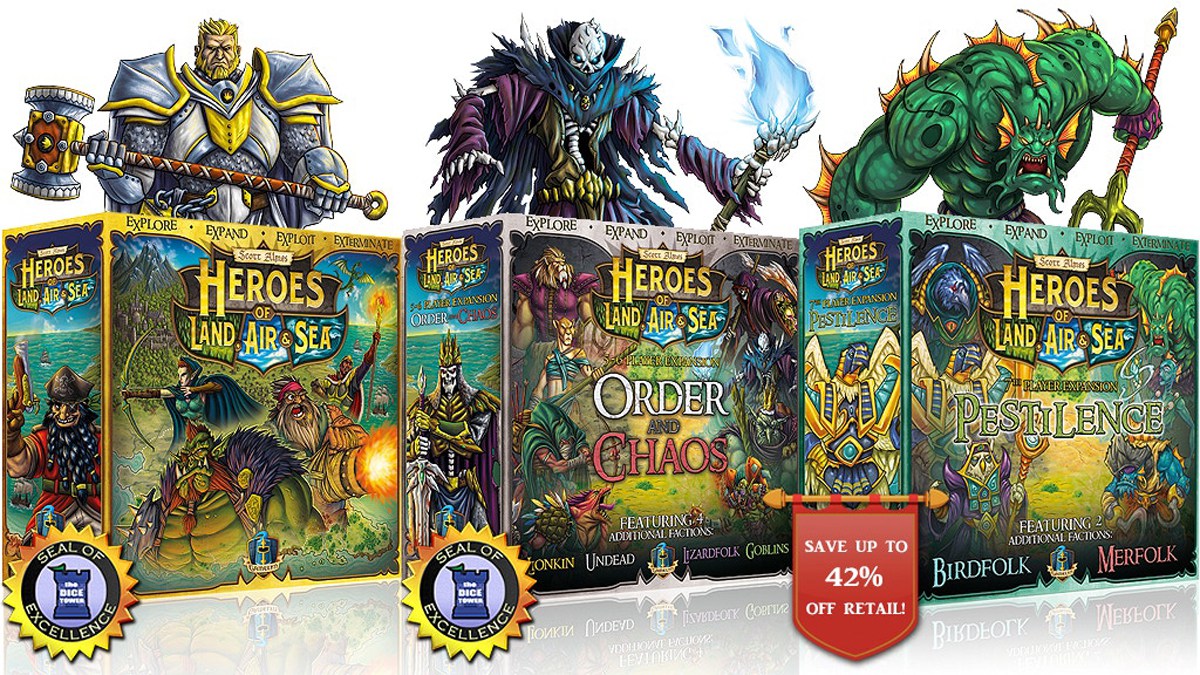 Songbirds may seem adorable and cheerful, but those tweets and chirps aren’t just for fun–they’re claiming territory and competing with other suitors. In Songbirds, delightfully cute birds engage in an intense battle for dominance.
Songbirds may seem adorable and cheerful, but those tweets and chirps aren’t just for fun–they’re claiming territory and competing with other suitors. In Songbirds, delightfully cute birds engage in an intense battle for dominance.
What Is Songbirds?
Songbirds is a card game for 1 to 4 players, ages 8 and up, and takes about 20 minutes to play. It’s currently seeking funding on Kickstarter, with a pledge level of $15 for a copy of the game. The game involves some bidding and bluffing but there is nothing inappropriate for younger players, yet there’s enough strategic choice to challenge adult players as well.
It was originally published in Taiwan by Homosapiens Lab and Jolly Thinkers; Daily Magic Games is running a Kickstarter campaign for a North American edition.
New to Kickstarter? Check out our crowdfunding primer, and visit our Kickstarter curated page for more projects we love.

Songbirds Components
Note: My review is based on the original version produced in Taiwan; the Daily Magic Version has a few tweaks to it but the artwork and component quality should be very close to final.
- 28 Songbird cards (7 each in 4 colors)
- 10 Berry tokens
- 2 Score cards
- 2 Special cards (double-sided)
- 5 Special Berry tokens
- 1 Owl card (Kickstarter limited exclusive)
- 1 Shrike card (Kickstarter limited exclusive)
Daily Magic Games is committed to publishing Songbirds regardless of the outcome of the Kickstarter campaign, but the Kickstarter will be an opportunity to get some exclusive bonuses, like wooden berry tokens and a special card not available in the planned retail edition.

The songbird cards are, as I mentioned before, adorable. There are four types of birds, which differ not only in color but also in patterns, and each one also has an associated flower, making it easy to distinguish the birds even apart from the colors. (The Daily Magic version will use the flowers instead of the bird heads on the corners of the card, making it a little friendlier for color blind players.) There are 7 cards for each bird type, with “volume” values from 1 to 7. I really love the illustrations on the cards, which depict the birds in various positions so that there’s a lot of visual variety when laying out all the cards on the table.
The special cards have different birds on each side, so you get a Crow, Hawk, Hummingbird, and Mockingbird—one of these four birds will be used when you play a 4-player game. (My had a double-sided Crow card, but the Daily Magic edition will have a new Hawk illustration on the back of the Crow, and then a new Hummingbird/Mockingbird card.)

The game is quite compact–just a deck of cards and some tokens–but still has a surprising amount of depth in the gameplay.
How to Play Songbirds
You can download a copy of the rulebook here.
The Goal
The goal of the game is to score the most points by winning berries for your favorite bird. (Solo rules and the cooperative variant will be explained separately below.)
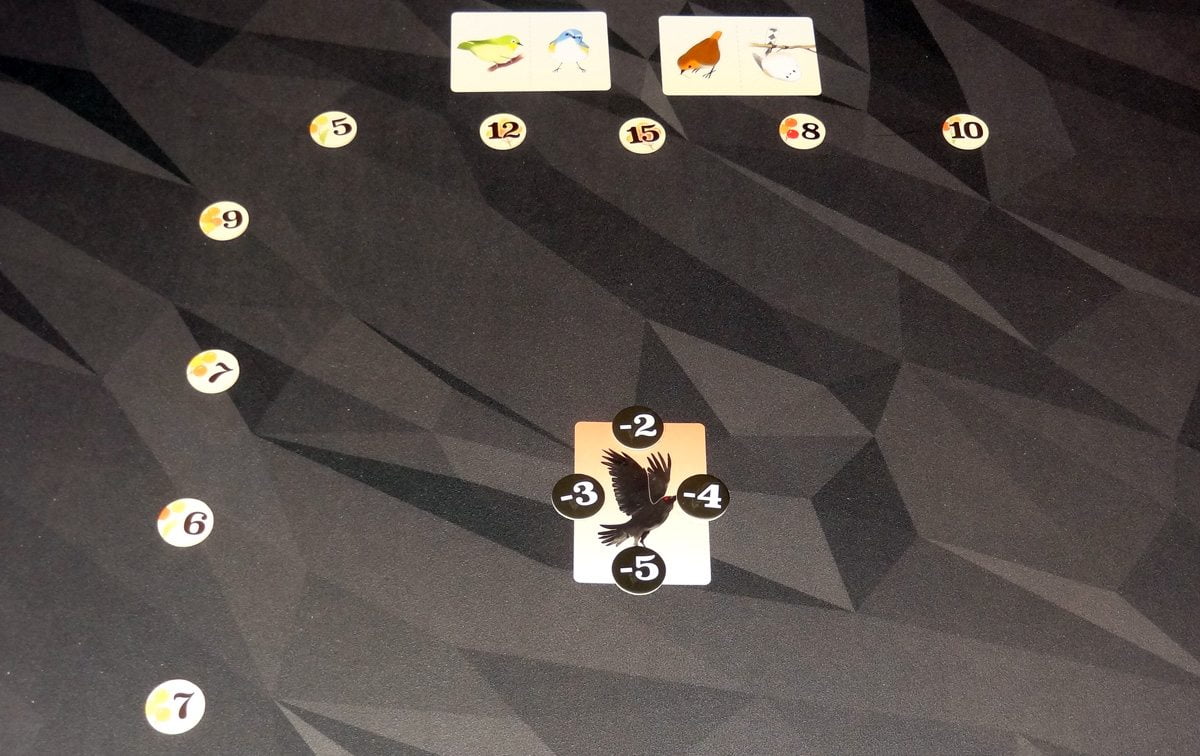
Setup
Mix up the berry tokens and set place them to form the border for a 5×5 grid of cards—5 berries across the top, 5 berries down the left side. Then flip the berries face-up. Place the two scoring cards above the grid area.
Shuffle the bird cards. In a 2- or 3-player game, deal one random bird card face-up in the center of the grid. In a 4-player game, place one of the special cards (Crow, Hawk, Hummingbird, Mockingbird) in the center of the grid instead, with the corresponding berry tokens placed on the special card.
Deal out the rest of the bird cards to the players. (In a 2-player game, you will have one card left—set it aside without letting anyone see it.)
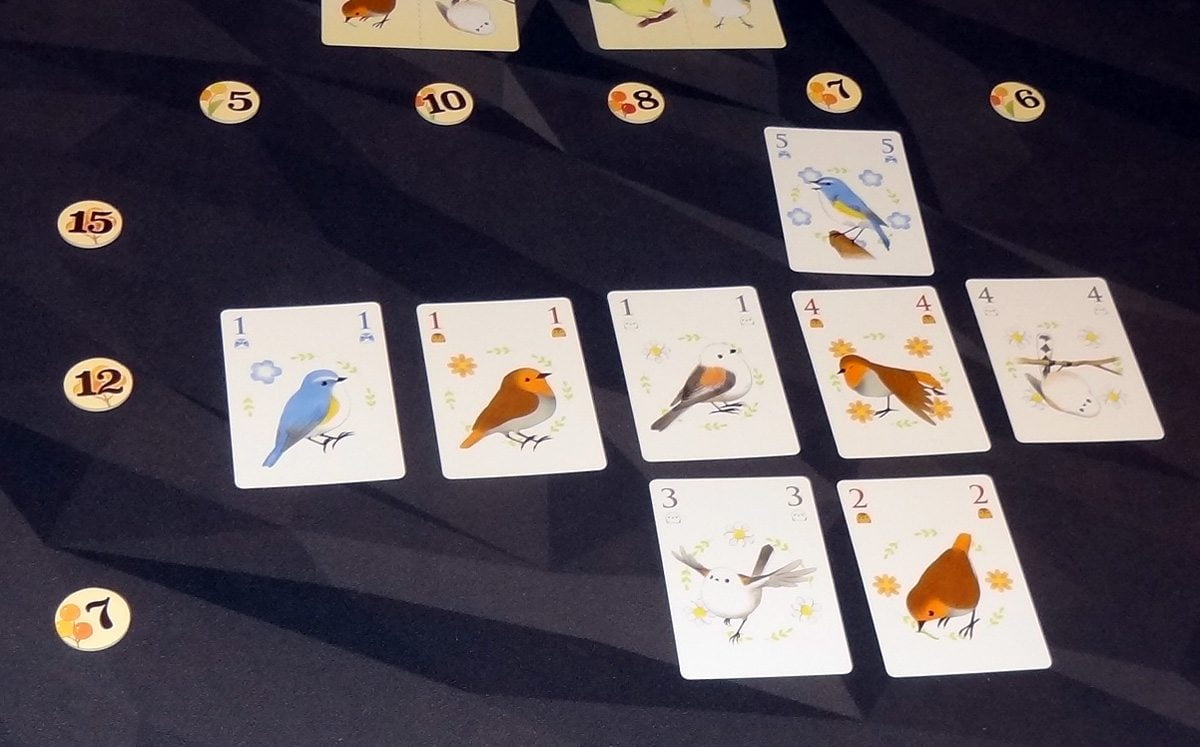
Gameplay
On your turn, place one bird card from your hand into the grid. Your card must be orthogonally adjacent to at least one card already in the grid.
If at any point a row or column is filled, you score that column or row and award the berry token to the winning bird by placing it on the matching scoring card. Total up the values of each bird represented in the row or column: the highest value wins. If there are ties, the tied birds cancel each other out, and the next-highest value wins. If all birds are tied, the berry is discarded. (Note: this is a slight change from the original rules, which awarded the berries only at the end of the game, which is why my photos show the berries still in place even for completed rows and columns.)
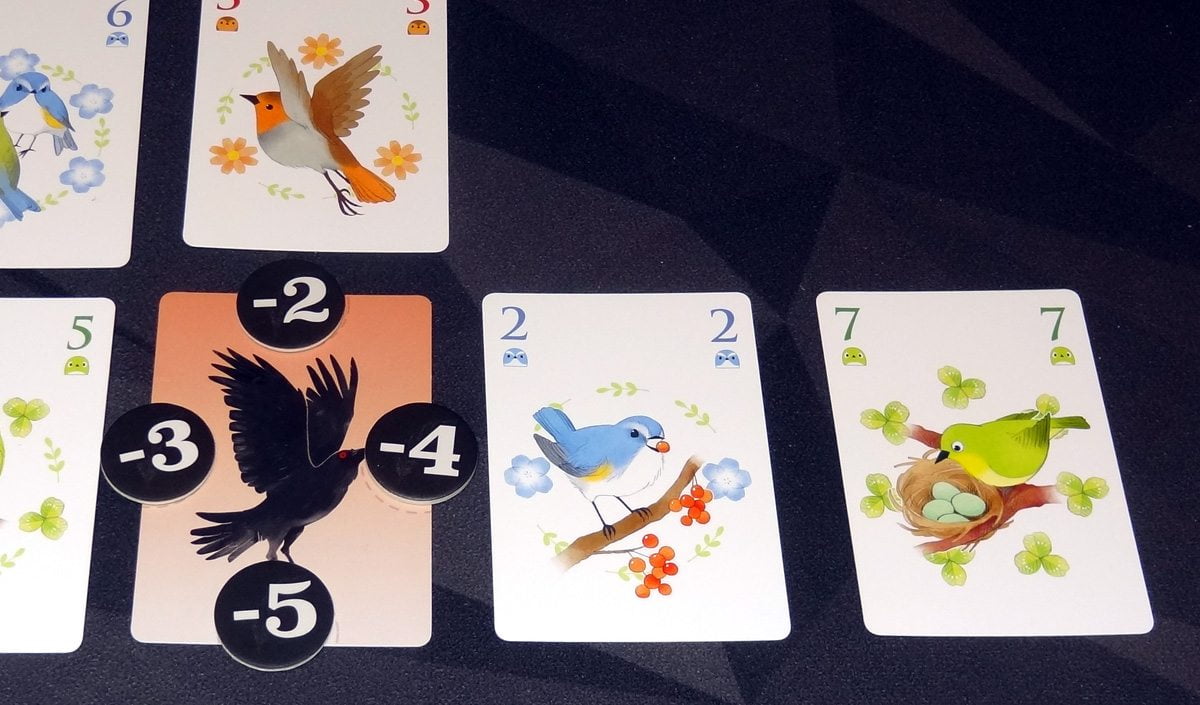
The special cards have additional berry tokens—the Crow and Hawk have negative berries, and the Hummingbird and Mockingbird have positive berries. These are awarded based on the cards in the same row and column as the special card. For instance, the Crow will give a berry to the bird that has the higher value in the two cards above it, the two cards to its right, the two cards to its left, and the two cards below it. The Hummingbird awards similarly, but for the bird that has the lower value in those sets. The Hawk and Mockingbird compare the set of four cards above and to the right, and the set of four cards below and to the left. (Ties cancel out as with the regular berries.)
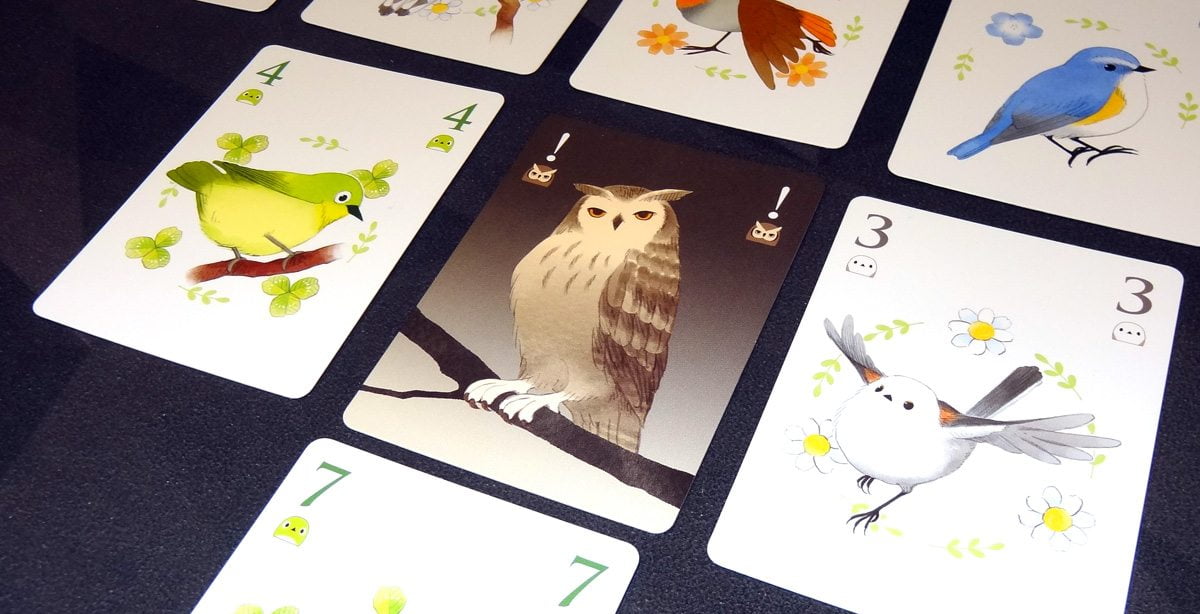
There is also an Owl variant: shuffle the Owl card into the bird deck before dealing cards to players. When you play an Owl, you replace a songbird anywhere, and then play that displaced songbird in a new legal position. The Owl will not change the award for a berry if it has already been awarded.
Finally, there is a Shrike variant: shuffle the Shrike card into the bird deck before dealing. When you play the Shrike card, you swap the berries in its row and column. The Shrike also subtracts 1 from the value of the birds in the four positions adjacent to it.
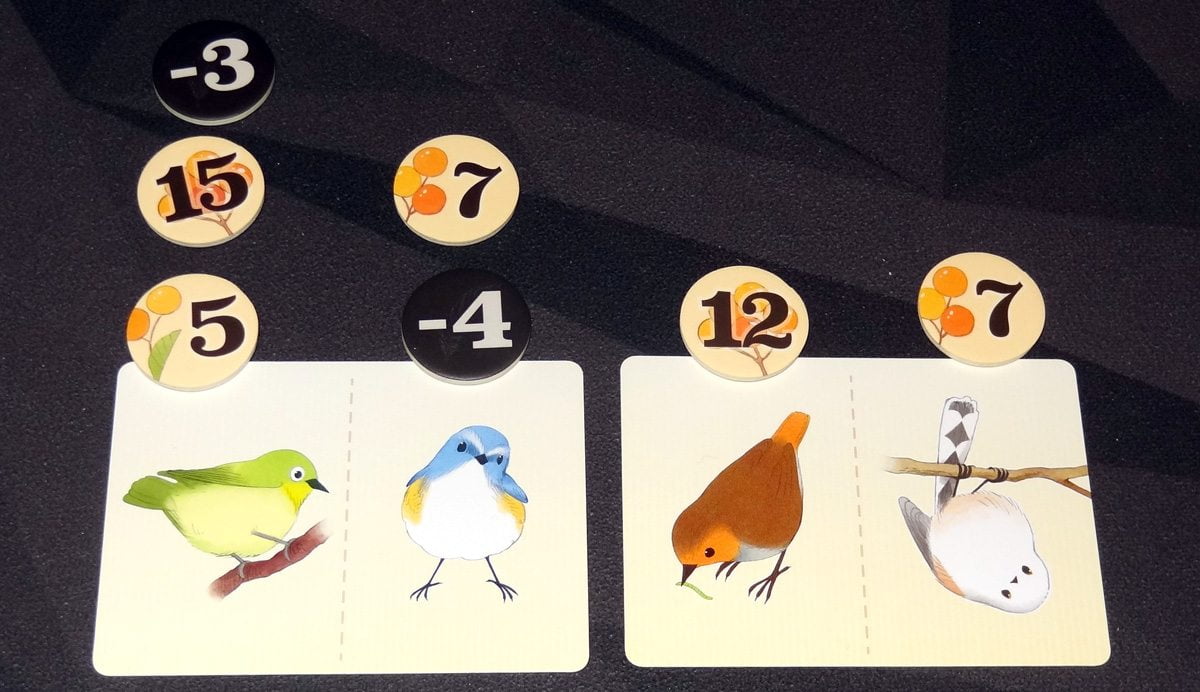
Game End
The game ends when the grid is filled. Each player will have one card left, which is now their favorite bird. You add your favorite bird’s value to the berries collected by that bird type to determine your score. Highest score wins, with ties going to the player with the highest value favorite bird.

Solo and Co-op Mode
The solo setup and play is a little different. When you set up, you deal an “x” of 9 cards in the grid rather than just the center card. You only deal yourself 1 card and then form a deck of cards to draw from. Each turn, you draw the top card of the deck, and then do one of the following:
- Place a card in the grid.
- Play a card as your favorite bird.
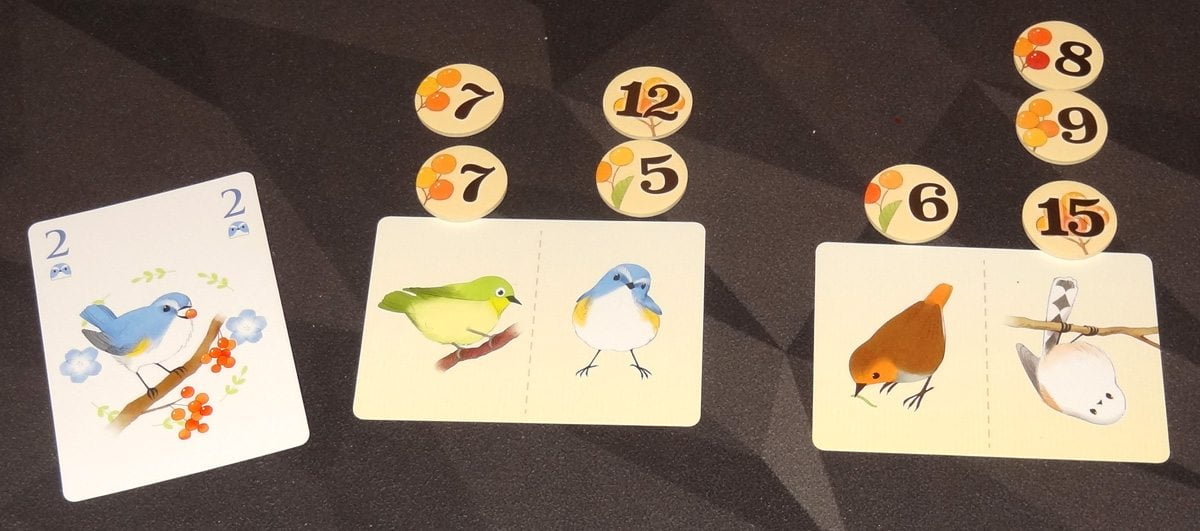
When the grid is filled, you score all the birds as usual. Your score is the total of your berries and favorite bird, minus the total berries of the other three birds. You compare your score to the chart to see how well you did. In the photo above, I picked the blue bird (value 2) as my favorite bird, so my score was (2+12+5) – (7+7) – 6 – (8+9+15) = -33.
The cooperative mode is similar, though each player is dealt 1 card. On your turn, you do the same as above, but only one player may choose a favorite bird for the whole team. There are some restrictions on what you may and may not discuss while playing.

Why You Should Play Songbirds
When I first opened up Songbirds, I thought, “Oh, what a cute little game!” I loved the colorful bird illustrations and I was expecting a light, simple game, but then I was totally surprised. While the gameplay itself is easy—play a card from your hand into the grid—the strategy will soon have you agonizing over each decision. I love the fact that I can set it up and teach it so quickly, and that such deep gameplay can emerge from a simple set of rules.
Songbirds is essentially an area control game, where the particular territories that matter are the rows and columns of the grid. Because of the random placement of the berries, the rows and columns aren’t equally valuable, so you generally want to focus on the highest values—but, as you’ll find out, you can’t just ignore everything else, either. And because tied values cancel each other out, sometimes it doesn’t take a very high number to win a berry: you might be able to sneak in and steal a berry while two other birds are fighting over it!
The trickiest part, though, and the source of most of that brain-burning, is that your favorite bird isn’t determined ahead of time: it’s simply the last card left in your hand, the one that you didn’t play. So as you play cards into the grid, trying to sway the balance for one bird or another, you’re also weighing which bird to hold back as your favorite. At the beginning of the game, you could choose any of the birds in your hand as your favorite … and then your options narrow down with every card you play, until at the end you’re left with one final, difficult choice.
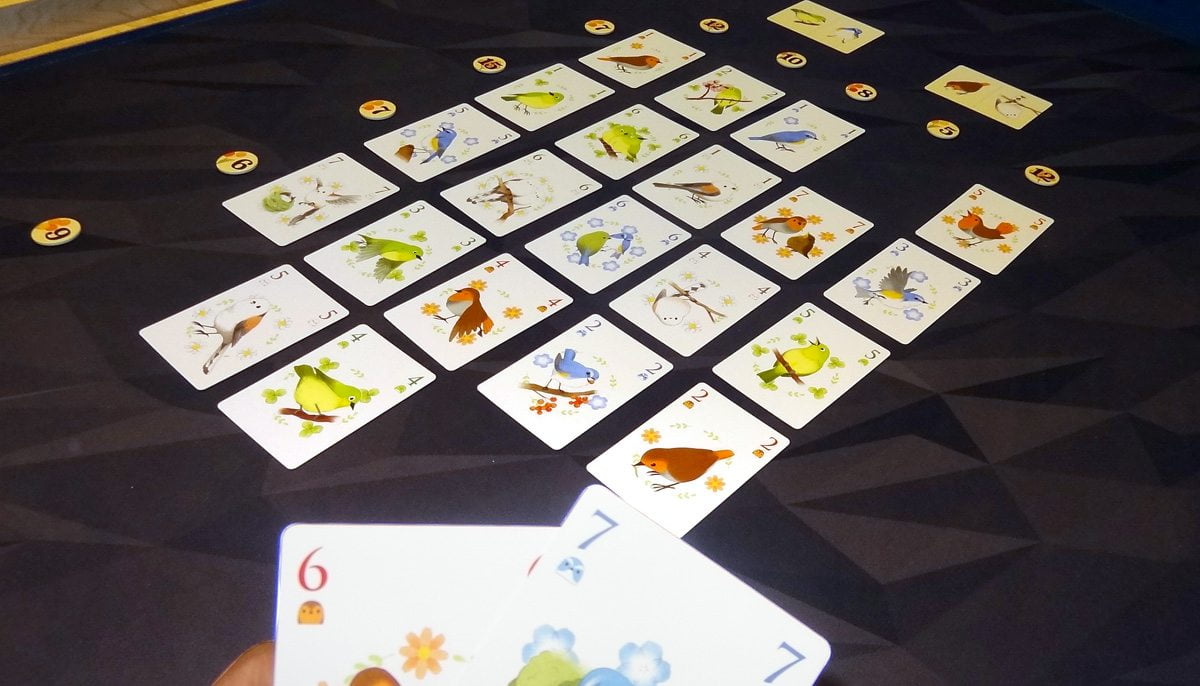
The other wrinkle is that the card you keep in your hand for scoring is therefore not in the grid helping you influence the outcome of a row or column. If you have two different bird colors left in your hand at the end, you might find that each one will sway the balance in favor of the one you played—and therefore is bad for the one you keep. Because of this, using other colors to cancel each other out through ties can be an important tactic, allowing you to claim berries for a color that you are not playing on the grid.
The value of the card you keep is also added to the score, which prevents ties between players who keep the same bird, giving an incentive to keep higher values in hand. But, again, that means you’re forfeiting a powerful card on the grid in order to keep it in your hand for the end, so it’s a tricky balance. The one thing I didn’t like about that scoring rule is that it can feel a bit too much like random chance when somebody wins because they kept the white 7 and you had the white 6—it doesn’t seem like there was much you could have done about that. This can be especially true in a 2-player game, because it’s quite likely that one player may end up with three of the four 7s, giving them a lot more options for a high-value favorite bird. I’m still not sure how exactly to address that perceived imbalance, other than to say that it becomes even more important to remember to use ties to cancel out birds.
In the four-player game, the added special card in the center allows for some other types of manipulation, and it makes the center row and column a little trickier—in general, you’ll want your color to be lower in those areas no matter which special card is used: the Crow and Hawk give negative berries to the higher value birds, and the Hummingbird and Mockingbird give positive berries to the lower value birds.
The solo/co-op mode is quite a challenge. Instead of just scoring higher than just each other bird individually, you’ll be comparing the score of your favorite bird against all three other birds. I didn’t fare so well on my own (-33 points!), but I did manage to get a superstar score (60 points!) while playing cooperatively. I think for those who find it a bit too intense, the cooperative mode is nice for maintaining the feel of figuring out a puzzle, but lets you put your brains together, which is nice.
Overall, I think Songbirds is a delightful brain-burner that will challenge you, whether you opt for the competitive or cooperative mode. I love how compact it is (the Daily Magic Games version will be in a 4″x6″ box, the same size as ManaSurge), and yet how big the gameplay can feel.
For more information or to make a pledge, visit the Songbirds Kickstarter page!
Click here to see all our tabletop game reviews.
If you’d like to stay up-to-date with all of our tabletop gaming coverage, please copy this link and add it to your RSS reader.
Disclosure: GeekDad received a copy of this game for review purposes.


